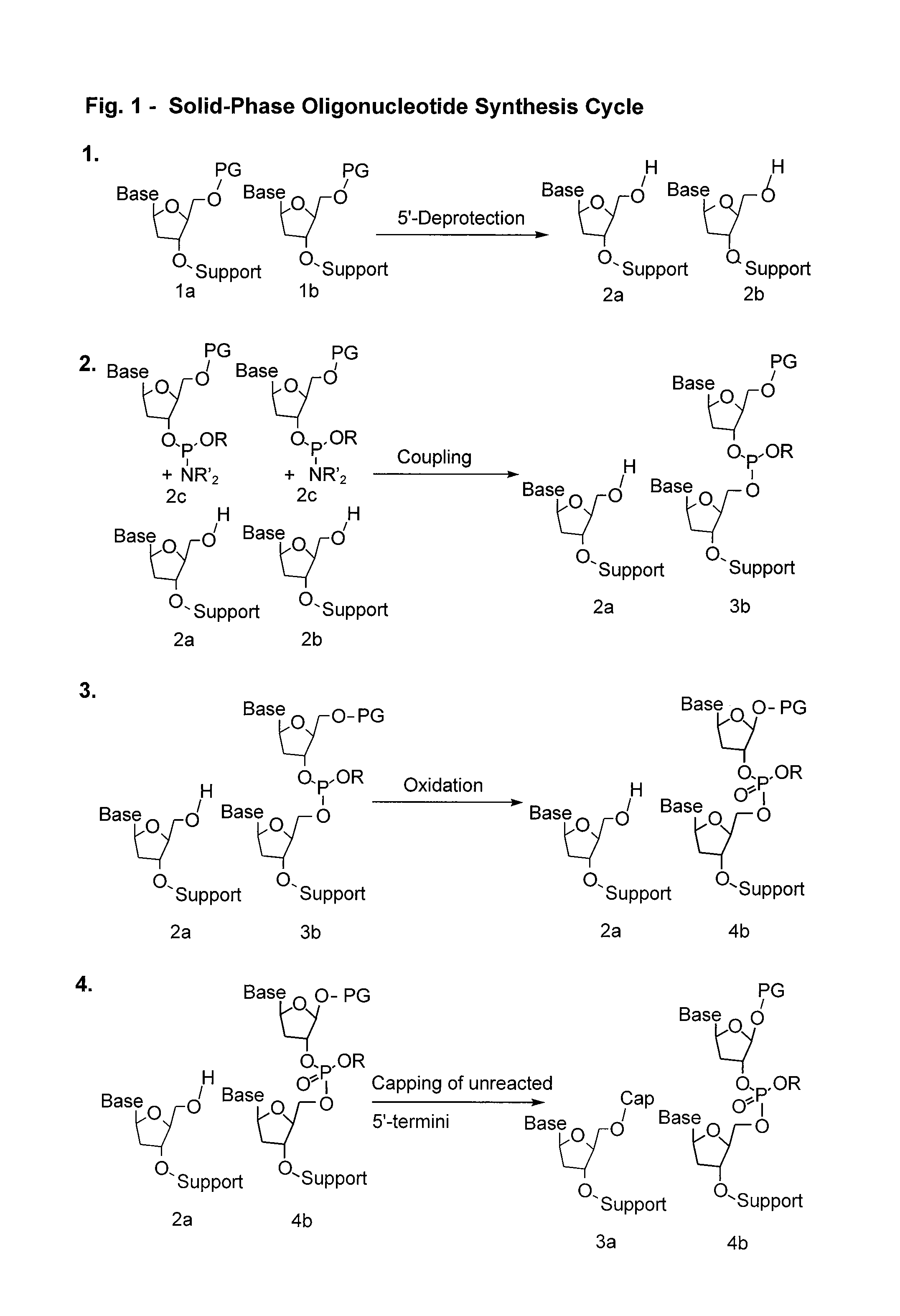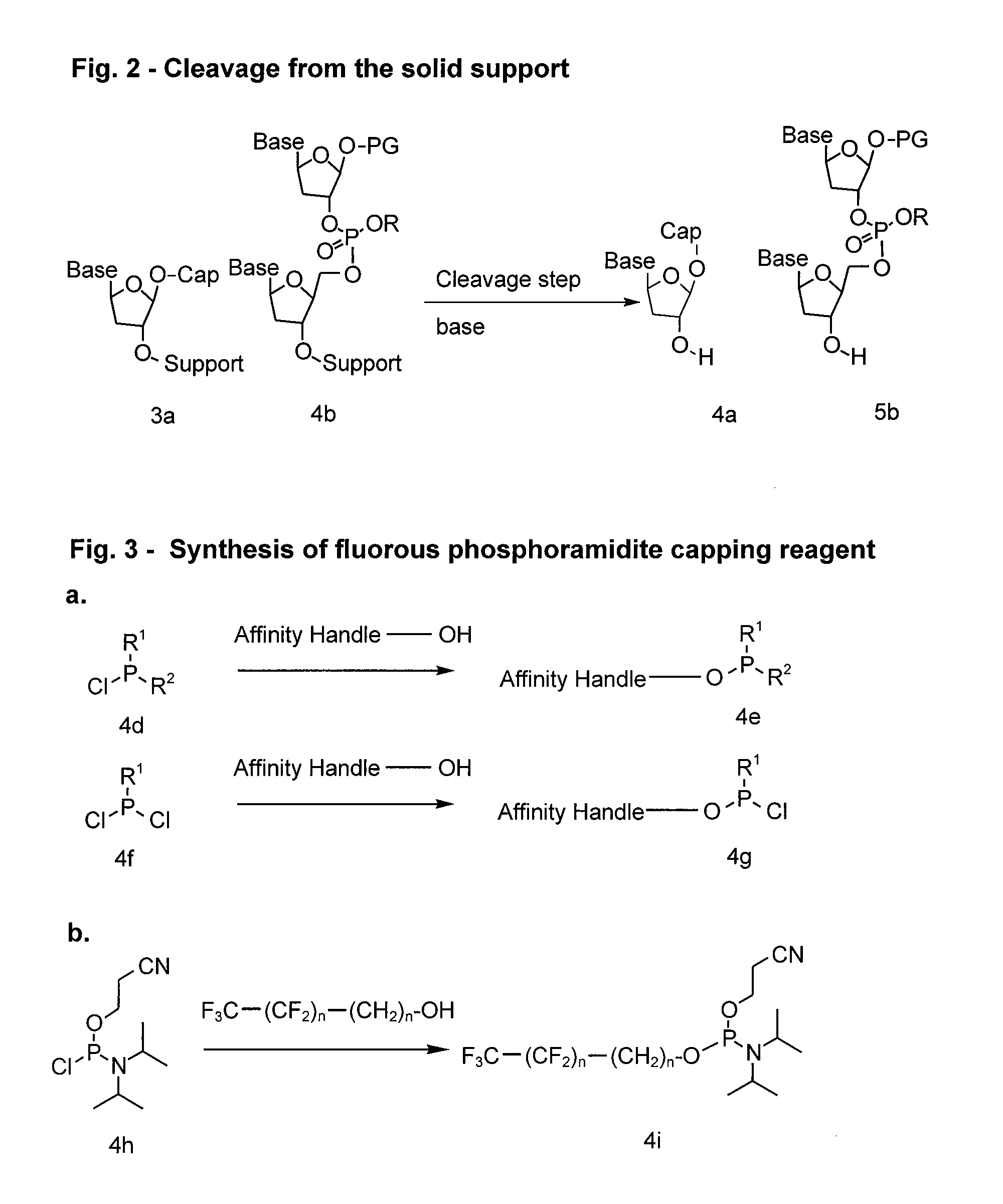Compounds and methods for synthesis and purification of oligonucleotides
a technology of oligonucleotide and synthesis method, which is applied in the field of compound and method for synthesis and purification of oligonucleotides, can solve the problems of complicated purification, limited scale on which oligonucleotide can be made and the resulting yield, and further increase of the problem of purification
- Summary
- Abstract
- Description
- Claims
- Application Information
AI Technical Summary
Benefits of technology
Problems solved by technology
Method used
Image
Examples
example 1
Preparation of Capping reagent 1: 2-cyanoethyl-N′N′-diisopropyl 3-perfluorhexyl-propyloxy-phosphoramidite
[0137]
Starting materialFWdAmountmmol.Eq.Rf6 propanol378.140.945g2.501.00Chlorophosphoramidite236.681.060.670mL3.001.20Hunig's base101.290.731.25mL8.983.59CH2Cl240mL
[0138]The synthesis of an exemplary fluorous derivatized phosphoramidite 4e was achieved generally as follows and as outlined in FIG. 4 below. Rf6 propanol (945 mg, 2.50 mmol, 1.0 equiv.) (FTI catalog #F017029) and Hunig's base (1.25 mL, 8.98 mmol, 3.60 equiv) were dissolved in 40 mL of CH2Cl2 in a 100 mL round bottom flask. 2-cyanoethyl disopropylchlorophosphoramidite (Aldrich catalog #30, 230-9) (670 μL, 3.0 mmol, 1.20 equiv) was then added over 5 minutes and stirring continued at room temperature. After 1 h the reaction was complete as observed by the disappearance of propanol by TLC (Eluent: 20% ethyl acetate in hexanes; Visualization: KMnO4 stain; Rf6 propanol: Rf=0.30; Product phosphoramidite: Rf=0.70). The react...
example 2
Preparation of Capping reagent 2: 2-cyanoethyl-N′N′-diisopropyl-3-perfluorooctyl-propyloxy phosphoramidite
[0139]
Starting materialFWdAmountmmol.Eq.Rf8 propanol478.141.2g2.511.00Chlorophosphoramidite236.681.060.670mL3.001.20Hunig's base101.290.731.25mL8.983.58CH2Cl240mL
[0140]Rf8 propanol (1.20 g, 2.51 mmol, 1.0 equiv.) and Hunig's base (1.25 mL, 8.98 mmol, 3.58 equiv) were dissolved in 40 mL of CH2Cl2 in a 100 mL round bottom flask. The chlorophosphoramidite (670 μL, 3.0 mmol, 1.20 equiv) was then added over 5 minutes and stirring continued at room temperature. After 1 h the reaction was complete as observed by the disappearance of propanol by TLC (Eluent: 20% ethyl acetate in hexanes; Visualization: KMnO4 stain Rf8 propanol: Rf=0.30; Product phosphoramidite: Rf=0.70). The reaction was diluted with CH2Cl2 (60 mL) and the organic layer was quickly washed with H2O, sat. NaHCO3 solution, and sat. NH4Cl solution (25 mL each). The CH2Cl2 layer was concentrated by rotary evaporation and the...
example 3
i. Automated, Cycled Solid-Phase Oligonucleotide Synthesis Procedures Using a Fluorous Capping Reagent (PFC8C3 Phosphoramidite)
[0141]A poly-T (T-15) sequence was synthesized on the ABI 394 instrument using the trityl-off cycle and a modified capping protocol. This experiment was designed in such a way that the coupling efficiency for each nucleotide addition step was reduced. This was accomplished by reducing the phosphoramidite concentration from the standard 0.1 M to 0.02 M. The reduced efficiency ensured the production of sufficient concentrations of the truncated sequences to make this example clearly illustrate the utility of this invention to rapidly purify the desired oligonucleotide away from the failure sequences. Standard base phosphoramidites were added using the standard 1 umol synthesis cycle with 30 s coupling time. PFC8C3 phosphoramidite was dissolved in acetonitrile at a concentration of 0.1 M and placed at bottle position 5 on the DNA synthesizer. The standard cappi...
PUM
| Property | Measurement | Unit |
|---|---|---|
| structure | aaaaa | aaaaa |
| purity | aaaaa | aaaaa |
| length | aaaaa | aaaaa |
Abstract
Description
Claims
Application Information
 Login to View More
Login to View More - R&D
- Intellectual Property
- Life Sciences
- Materials
- Tech Scout
- Unparalleled Data Quality
- Higher Quality Content
- 60% Fewer Hallucinations
Browse by: Latest US Patents, China's latest patents, Technical Efficacy Thesaurus, Application Domain, Technology Topic, Popular Technical Reports.
© 2025 PatSnap. All rights reserved.Legal|Privacy policy|Modern Slavery Act Transparency Statement|Sitemap|About US| Contact US: help@patsnap.com



